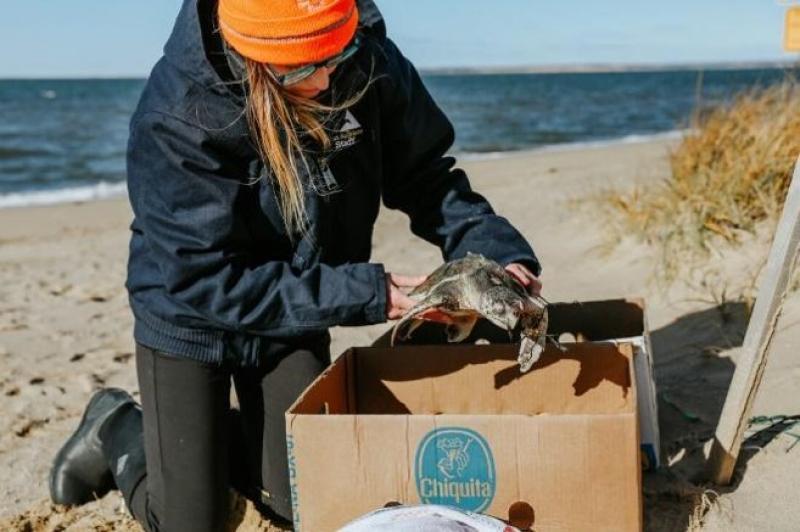
Massachusetts Cold-stunned Sea Turtles: A sign of climate change?
by NOAA Fisheries 22 Jun 2024 16:09 UTC

A responder rescues a cold-stunned sea turtle from a Cape Cod beach © Mass Audubon Wellfleet Bay
The number of cold-stunned turtles on Cape Cod are increasing, likely in part due to climate change. We are adapting our response and planning for the future to accommodate increasing numbers.
Four species of sea turtles—Kemp's ridley, loggerhead, green, and leatherback—are seasonal residents of New England. They arrive in May and June, feeding in our coastal waters through the summer and early fall. When temperatures drop in mid-fall, these reptiles need to migrate south into warmer waters for the winter. However, sometimes their migration is affected by geographic barriers: The hook shape of Cape Cod can trap them within Cape Cod Bay for weeks to months. This puts turtles at risk of being exposed to waters that are too cold for them.
Cold-stunned Turtles Need Rescue
Since they are cold-blooded, sea turtles' body temperatures mirror those of surrounding waters. When turtles have a low body temperature, they stop feeding; their body systems slow down; their immune systems become suppressed. This is all part of a condition called cold stunning. When cold-stunned turtles wash up on local beaches, they need immediate rescue or they will not survive. Luckily,the Sea Turtle Stranding and Salvage Network collects sick, injured, and cold-stunned turtles from beaches and brings them to rehabilitation facilities for medical care.
In Massachusetts, Mass Audubon’s Wellfleet Bay Wildlife Sanctuary rescues cold-stunned sea turtles off Cape Cod beaches. They bring live turtles to two Massachusetts rehabilitation facilities: the New England Aquarium and the National Marine Life Center. There, turtles are slowly warmed up, given medical care, reintroduced to swimming and feeding, and stabilized. It can take weeks to months for these debilitated turtles to be healthy enough to be released again into the ocean.
Increasing Cold Stun Numbers
The geographic structure of Cape Cod makes Massachusetts a hotspot for cold-stunned sea turtles. Turtles have been stranding in this area for decades, but the number of cold-stunned turtles is steadily increasing over time. The annual average of Massachusetts cold-stunned turtles in the last 5 years is 739, compared to 20 years ago when it was only 139. There are likely multiple reasons for this increase, but one important factor is climate change. Cape Cod Bay is part of the Gulf of Maine, which is warming faster than most other bodies of water in the world. These warm waters likely result in more sea turtles moving into the area, either following currents or prey.
The increase in cold-stunned strandings means rehabilitation facilities in Massachusetts do not have the capacity to care for all live turtles that strand each year. Most cold-stunned turtles must be transported to rehabilitation facilities throughout the East and Gulf coasts to continue their care. Many turtles are transported via flight with volunteer "Turtle Fliers," pilots with a non-profit organization called Turtles Fly Too. This rescue effort involves a great deal of coordination and collaboration between hundreds of staff and volunteers of non-profit organizations, as well as state and federal agencies.
Planning for the Future
We are coordinating with our northern partners in Canada to plan for potential increases in stranding numbers in that area. In the last 5 years, only one or two cold-stunned turtles were documented in Atlantic Canada each year. That number increased sharply to 16 turtles in 2023. Is this an anomaly or a sign of what is to come? Although these turtles were all dead when they washed up, if numbers increase, live turtles may also start to strand. We have already started discussions with the Department of Fisheries and Oceans Canada, the Canadian Sea Turtle Network, and the U.S. stranding network partners to plan for this possibility. As climate change continues, we will work with all partners to monitor and respond to sea turtle cold-stunned strandings, wherever they may occur. The ultimate goal is to help recover sea turtle populations.